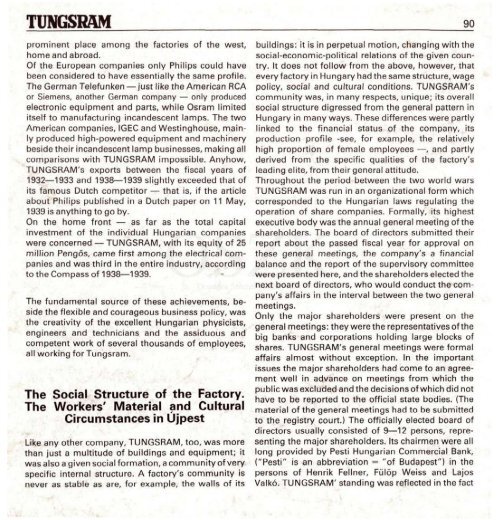THE HISTORY OF TUNGSRAM 1896-1945 - MEK
THE HISTORY OF TUNGSRAM 1896-1945 - MEK
THE HISTORY OF TUNGSRAM 1896-1945 - MEK
- No tags were found...
You also want an ePaper? Increase the reach of your titles
YUMPU automatically turns print PDFs into web optimized ePapers that Google loves.
<strong>TUNGSRAM</strong> 90prominent place among the factories of the west,home and abroad.Of the European companies only Philips could havebeen considered to have essentially the same profile.The German Telefunken — just like the American RCAor Siemens, another Gernnan company — only producedelectronic equipment and parts, while Osram limiteditself to manufacturing incandescent lamps. The twoAmerican companies, IGEC and Westinghouse, mainlyproduced high-powered equipment and machinerybeside their incandescent lamp businesses, making allv comparisons with <strong>TUNGSRAM</strong> impossible. Anyhow,<strong>TUNGSRAM</strong>'S exports between the fiscal years of1932—1933 and 1938—1939 slightly exceeded that ofits famous Dutch competitor — that is, if the articleabout Philips published in a Dutch paper on 11 May,1939 is anything to go by.On the home front — as far as the total capitalinvestment of the individual Hungarian companieswere concerned — <strong>TUNGSRAM</strong>, with its equity of 25million Pengos, came first among the electrical companiesand was third in the entire industry, accordingtotheCompassof 1938—1939.The fundamental source of these achievements, besidethe flexible and courageous business policy, was- the creativity of the excellent Hungarian physicists,engineers and technicians and the assiduous andcompetent work of several thousands of employees,all working forTungsram., ,..-. . . -...-• ;. ...U'-.-The Social Structure of the Factory.The Workers' Material and CulturalCircumstances in UjpestLike any other company, <strong>TUNGSRAM</strong>, too, was morethan just a multitude of buildings and equipment; itwas also a given social formation, a community of veryspecific internal structure. A factory's community isnever as stable as are, for example, the walls of itsbuildings: it is in perpetual motion, changing with thesocial-economic-political relations of the given country.It does not follow from the above, however, thatevery factory in Hungary had the same structure, wage **policy, social and cultural conditions. <strong>TUNGSRAM</strong>'Scommunity was, in many respects, unique; its overallsocial structure digressed from the general pattern inHungary in many ways. These differences were partlylinked to the financial status of the company, itsproduction profile -see, for example, the relativelyhigh proportion of female employees —, and partlyderived from the specific qualities of the factory'sleading elite, from their general attitude.Throughout the period between the two world wars<strong>TUNGSRAM</strong> was run in an organizational form whichcorresponded to the Hungarian laws regulating theoperation of share companies. Formally, its highestexecutive body was the annual general meeting of theshareholders. The board of directors submitted theirreport about the passed fiscal year for approval onthese general meetings, the company's a financialbalance and the report of the supervisory committeewere presented here, and the shareholders elected thenext board of directors, who would conduct the company'saffairs in the interval between the two generalmeetings.... •Only the major shareholders were present on thegeneral meetings: they were the representatives of thebig banks and corporations holding large blocks ofshares. <strong>TUNGSRAM</strong>'S general meetings were formalaffairs almost without exception. In the importantissues the major shareholders had come to an agreementwell in advance on meetings from which thepublic was excluded and the decisions of which did nothave to be reported to the official state bodies. (Thematerial of the general meetings had to be submittedto the registry court.) The officially elected board ofdirectors usually consisted of 9—12 persons, representingthe major shareholders. Its chairmen were alllong provided by Pesti Hungarian Commercial Bank,("Pesti" is an abbreviation = "of Budapest") in thepersons of Henrik Fellner, FiJIop Weiss and LajosValko. <strong>TUNGSRAM</strong>' standing was reflected in the fact








![Letöltés egy fájlban [4.3 MB - PDF]](https://img.yumpu.com/50159926/1/180x260/letaltacs-egy-fajlban-43-mb-pdf.jpg?quality=85)







